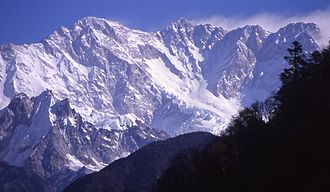Kangchenjunga
![]()
This article is about the mountain. For the Indian feature film, see Kanchenjungha.
pd3
pd5
fd2
The Kangchendzönga (Tibetan གངས་ཆེན་མཛོད་ལྔ Wylie gangs chen mdzod lnga་, Nepali कञ्चनजङ्घा Kañcanjaṅghā, Hindi कंचनजंघा Kañcanjaṅghā, pronunciation in the last two cases Kanchanchanga, hence the English spelling Kangchenjunga; often called Kantsch in German mountaineering jargon) is the third-highest mountain on Earth at 8586 m and also the easternmost eight-thousander.
The border between Nepal and the Indian state of Sikkim runs across its summit. Since the annexation of the former kingdom of Sikkim to the Indian Union in 1975, it is the highest mountain in India, ahead of Nanda Devi.
Until 1852, it was believed that Kangchendzönga was the highest mountain on earth. Only the calculations of the trigonometric survey of India by the British in 1849 proved that Mount Everest and K2 are even higher, making Kangchendzönga the third highest mountain on earth.
Kangchendzönga was first climbed on May 25, 1955 by George Band and Joe Brown. The British honored the beliefs of the people of Sikkim, who revere the peak as a sacred mountain, by stopping a few steps short of the actual summit. Many successful climbs since then adhered to this tradition. Climbing difficulties no longer offer the last meters of altitude.
Name
The name Kangchendzönga comes from Tibetan and consists of the four words (in the transcription according to Wylie) gangs "snow", chen "big", mdzod "treasury" and lnga "five", which can be translated as "The five treasuries of the big snow". This could mean either the five highest peaks or, according to G. O. Dyhrenfurth, the five main glaciers of the mountain.
The peaks
Kangchendzönga is the only eight-thousander where three peaks other than the main peak reach an altitude of more than 8000m. The (presumably) namesake five peaks of Kangchendzönga are:
| Summit | Height | Schartenhöhe |
| Kangchendzönga | 8586 m | 3922 m |
| Kangchendzönga West Peak (Yalung Kang) | 8505 m | 135 m |
| Kangchendzönga South Summit | 8476 m | 116 m |
| Kangchendzönga-Middle Summit | 8473 m | 63 m |
| Kangbachen Peak | 7902 m | 103 m |
Other mountains of the massif
From the main summit of Kangchendzönga, four long ridges descend in an x-shape in all directions: North and West ridges begin at the main summit. To the southeast, an almost horizontal ridge runs across the middle to the south summit, where the south and east ridges branch off.
- The west ridge runs on the Nepalese side over the west peak and Kangbachen to the 7710 m high Jannu.
- The east ridge finally ends at Siniolchu (6888 m) in Sikkim.
- The south ridge runs over Kabru North (7338 m), Kabru South (7316 m) and the Rathong peaks, which are up to 6678 m high. It forms the border between Nepal and India.
- The peaks of the North Ridge are also on the border. The North Ridge extends over the secondary peak Kangchendzönga North (7741 m), the Twins and Tent Peak to Jongsong La, a 6120 m high pass on the border with Tibet.
· 
View from the south of Tiger Hill (Darjeeling): In the sun the south summit and the south and east ridge, in the shadow on the left above the south summit the three other 8000m peaks, on the far left, also in the sunlight, Jannu

From left to right: West summit, main summit, middle summit, south summit
Search within the encyclopedia